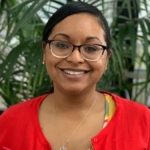My Community Through the Lens: A Youth Photovoice Program Creating Advocates for Health
December 7, 2022 by Melissa Baiyewu, MHA, CHES
Contrast, clarity, lighting, angles and color – all key components to a good photograph, but behind those structures lies a story that resonates with an audience and can be worth more than the words used to describe that very same image. The art of storytelling is valued across communities around the globe and pictures are part of a universal language that can be interpreted in various forms and used as a tool to document and bring to life what we see around us. Children’s National Hospital (CNH), premier pediatric health care system serving the Washington, DC Metropolitan area wanted to capture the voices and stories of those living in the communities we serve and through partnership, transformative education, and community engagement we invited youth from across our region to participate in a Youth Photovoice Program. The program called “My Community Through the Lens” allowed youth an opportunity to share their personal stories of health in their communities with a larger diverse audience of community stakeholders and inform the CNH 2022 Community Health Needs Assessment.
Photovoice is a Community Based Participatory Research method that involves giving cameras to people to take photographs that illustrate issues that concern them (Wang & Burris, 1997). In 2021, The Community Affairs department of the Child Health Advocacy Institute, committed to developing strong partnerships that help to increase advocacy and community engagement, planned, developed and led a Youth Photovoice program, in partnership with the Rodham Institute at The George Washington University. Aligned by our core missions to advance health equity for all, we implemented a program that provided a space for youth to share their experiences and understanding of the agents and barriers to achieving optimal health in their communities. Over an eight-week series, participants learned photography skills and gained knowledge around health equity and the social and structural determinants that impact community health.
The program’s curriculum was developed to promote empowerment, civic engagement, critical consciousness with connection to improving community health, and social capital among the participating youth. Participants were recruited from various partnering youth serving organizations, such as the Boys and Girls Club of Greater Washington and the Families First DC Family Success Centers. Each partner fully engaged youth and supported their participation in the program, even providing them with safe places to meet in – person and access technology necessary to join each virtual meeting. With over 20 youth in the program, each joined in a series of learning sessions and group dialogues that allowed them to engage and learn from facilitators, guest speakers and peers. Participants were also exposed to a variety of career and educational paths as part of the program.
Cell phone cameras were used to capture firsthand photos to illustrate their community and capture the essence of a larger part of their story. Coupled with the knowledge gained from the learning sessions, each participant prepared an exhibit of photos and narratives that displayed their perspectives, concerns, and hopes for improved health outcomes in the communities they reside. Participants were invited to present their findings in form of photos and narration and were then able to share their personal and collective stories around neighborhood level assets and challenges that impact community health outcomes. Participants were also encouraged to share their experience in the program and their recommendations to advance health equity with a diverse audience consisting of community leaders, stakeholders, and faculty and staff from both Children’s National Hospital and The George Washington University.
Curriculum Overview:
Lesson 1. Overview of Photovoice and Empowerment Education / Concepts and Ethics of Photography
Lesson 2. Health Equity and the Social and Structural Determinants of Health
Lesson 3. A Look into Health in Our Community
Lesson 4. Racism, Social Justice, and Using Civic Engagement to Address the Social and Structural Determinants of Health
Lesson 5. Policy and Advocacy with a Health Equity Lens
Lesson 6. Identifying Community Assets and Challenges
Lesson 7. Use of Strength Based and People First Language when Describing Communities and Advocacy 101 – The Power of Voice and Action to Create social Change for a Cause
Lesson 8. Final Exhibit and Youth Presentations
Included here are some of the photographs taken by our youth participants and several of the common themes that emerged from the photovoice prompts, narrative descriptions of each photograph and group dialogue.
The Youth Photovoice Program engaged a group of students from across the region to help identify community level health influences and helped them to create advocacy approaches to promote health in their own communities. The Community Affairs Department actively seeks community voice to shape programs, policies and initiatives. The input provided by our youth is critical in helping our hospital develop a strategic plan to address the needs of the community and work to improve health and wellbeing for our patients and families. Children’s National is required to conduct a Community Health Needs Assessment every three years. We used the input provided by participants of the Youth Photovoice program to help inform the CHNA published in June 2022 and our response in developing an actionable plan to provide resources and improve community health through our Community Health Improvement Plan published in November 2022. You can find both the 2022 CHNA and 2022 CHIP by visiting: https://childrensnational.org/advocacy-and-outreach/child-health-advocacy-institute
The Youth Photovoice Program has been essential in providing an opportunity to encourage youth to feel empowered and to amplify their voices, concerns and stories behind the changes they want to see made that will not only impact themselves, but the health and well – being of the larger community. Changes for a safe, equitable, and healthy community for all.

Program Manager of Health Promotion & Disease Prevention within the Child Health Advocacy Institute at Children's National Hospital